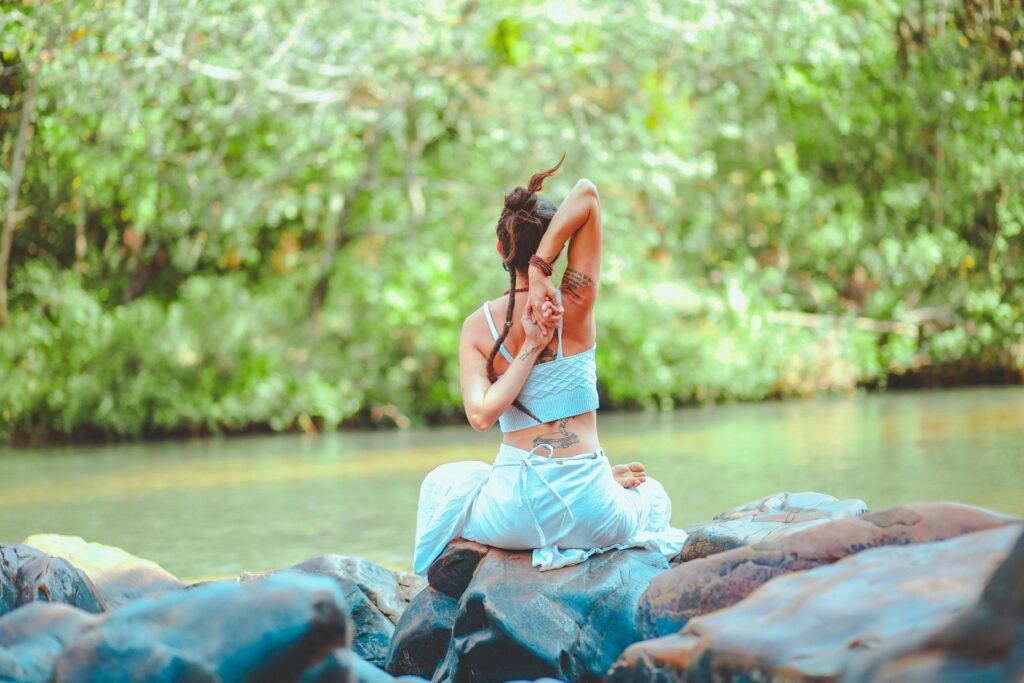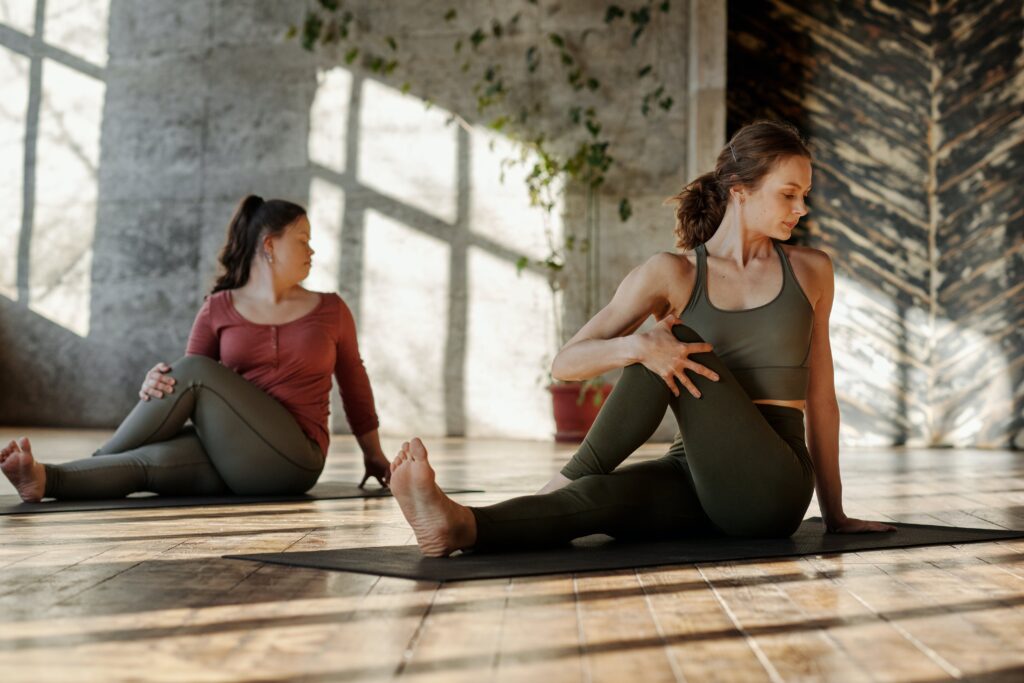
Let’s talk Anatomy
Your Body is a Temple, not a cookie clutter: Embracing Unique Anatomy in Yoga
Let’s talk anatomy. We’ve all seen the instagram posts and iconic images of people contorting themselves into seemingly impossible shapes. But what about those of us whose bodies don’t quite fit the mould? Here we celebrate the beauty and power of our wonderfully unique anatomy and how an awareness of this can deeply benefit our yoga.
No Two Bodies Are Alike
It’s important to understand that our bodies are incredibly diverse. We come in all shapes, sizes, and with varying bone structures, muscle lengths, and joint flexibilities. What’s easy for one person may be a struggle for another, and that’s perfectly okay, and more than that, its bloody amazing.
I have had a yoga practice for many years and when I decided to do my initial training in India in 2017, I had severe imposter syndrome. I worried that my physical practice wasn’t strong enough. I have never particularly enjoyed inversions or going upside down and I had never done a headstand. There were varying physical abilities on my course and I loved it and the challenges it brought me and I learnt how to headstand.
Now though I choose not to do headstands because I just don’t think it’s that good for me. I feel pressure behind my eyes, and although most of the weight is in my arms, I don’t enjoy the sensation on my head and neck- so I stopped, a personal choice and one which works for me as I am listening to my body instead of forcing into shapes that it doesn’t want to be in. And who am I going upside down for anyway? Only my ego, of course.
The Myth of the “Perfect” Pose
Let’s look more closely at the physical practice of yoga, Yogasana.
Yogasana is about exploring your own individual range of motion and finding modifications that work best for you. There’s no one-size-fits-all approach when it comes to yoga.
Celebrating Your Uniqueness
As a yoga teacher in group settings, it is my job to guide, suggest and lead. I can observe and give modifications and hands on assists to help safe alignment or to deepen your pose but only you truly knows your body and how it feels in your practice. And with practice we are able to better listen to our bodies, to pay attention to any pain or discomfort and modify poses accordingly. It can be a battle with our ego I know, but try to embrace using props like blocks, straps, or bolsters to support your body and to find safe alignment. It can be empowering to surrender to this. To acknowledge the power there is in rest and stillness too. If I’m given the opportunity in class to come to a restorative version of the pose, I usually grab it.
Alignment over Depth
When we focus on alignment over depth, we are able to maintain proper form in a modified version of a pose rather than to push ourselves into a deeper version that might compromise our form. I would also advise exploring different styles of yogasana.There are many styles, each with its own emphasis. Finding a style that resonates with your body and preferences is key.
By embracing your unique anatomy and letting go of the pressure to conform to idealised poses, you can cultivate a deeper connection to your body and self.
Dancers and Vikings
I have a wonderful yin teacher in Ibiza who I trained with in 2020. She described two distinctive body shapes as Dancers and Vikings. Those who are very flexible and need more mobility and those who are strong but require more flexibility to be better balanced. Dancers benefit more from a strong vinyasa flow class, whereas Vikings benefit from practising more yin, holding the poses for longer and targeting the deeper connective tissue.
Yoga has a reputation for stretching, and many people come to yoga seeking more flexibility. Think of the hamstrings. It a common belief that these muscles need to be more flexible. And, many yogis will want to devise the most effective stretch to make this happen. In reality, in our Yogasana, we need to be focusing on developing mobility and strength alongside flexibility in order to be better balanced and able to be active and mobile.
Passive and active range of motion
Range of motion is the amount of movement at a specific joint. Passive range of motion is the amount of movement at a joint created by an external force. The muscle that creates the movement does not contribute. For example, to move through passive range of motion in the hamstring, you could do supta padangusthasana A (hand to big toe pose, reclining with a strap around the foot and raising the leg). You are using a strap within the hand to move the leg into flexion, the hip flexors are not (or very minimally) engaged in order to create the range. Or, a helper could raise your leg for you.
Active range of motion is the movement created by the muscles that cross the joint. In the example of Supta Padangusthasana, an active range of motion would be to recline, and to not use the hand or strap. Instead raise the leg to a flexed position. This range is created by the hip flexors.
Both types of range are useful to maintaining mobility of a joint and connective tissue. However, passive range of motion will not contribute to strength building, and active range of motion can.
Flexibility and Mobility
I will add two more terms interrelated with each other, and the terms above: flexibility and mobility. Flexibility is part of range of motion, it’s defined as the extensibility of soft tissues, how much these tissues can extend. That can be created by passive or active range of motion.
Mobility (or, functional mobility) depends on the strength of your body, it’s the ability to move unassisted through a range. This is created by active range of motion. How strong the muscle is and how it can move the joint. You can back up functional mobility with passive range, but ultimately, this depends on your strength.
To wrap up, it’s all about balance in our Yogasana. Perhaps try playing more with your active range if your tendency is to go as deep as you can and dump into the joints.
Asana- A Gateway to Yoga
Many of us find yoga through the physical or asana practice. It offers us a tangible and accessible way back home to who we are. We then realise the layers and depths there are to our practice, the power of presence, of embodiment, of connection, to name a few. It is a doorway to discovering all the limbs or aspects of yoga and all it brings to us. My point here is not to diminish the importance of our asana practice as it serves us greatly but to emphasise how it is not all of yoga. The physical side is an energy practice of embodiment and connection over forcing ourselves into shapes we are not built for.
What is Advanced Yoga?
I don’t know what advanced yoga is. Is it an ability to do physically impressive poses? But then is a gymnast an advanced yogi in their first class? Is it an ability to be aware of every body part in every pose? Or to keep the mind calm and maintain connection to the breath through challenge? To be still in meditation?
There are accomplished yogis who do not have a physical practice but who have expanded awareness and have mastered the mind. I’m not sure if there is a definition to what encompasses advanced yoga so just you just do you and practise in a way which brings you the greatest peace and joy.
Remember that your body is a gift, not a project. Appreciate its unique strengths and celebrate its limitations and learn to listen to its whispers as well as its shouts. Focus on the journey and the progress you’re making. The process of exploration and mindful movement is what truly matters in yoga. Yoga is for every BODY. Regardless of your body shape, size, or flexibility level, yoga offers something for you.
If you’d like more information on yoga philosophy please contact me or book here to practise with me in Marlow, Twickenham and online.
With love
Anney xx




